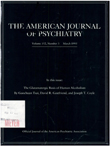Personality disorders in treatment-seeking combat veterans with posttraumatic stress disorder
Abstract
OBJECTIVE: Many patients with posttraumatic stress disorder (PTSD) appear to have co-occurring symptoms of character pathology; however, to date there have been no empirical studies of comorbid clinician- rated axis II personality disorders in war veterans with chronic PTSD. The authors' objective was to assess DSM-III-R personality disorders in treatment-seeking combat veterans with PTSD. METHOD: They used the Personality Disorder Examination, a standardized diagnostic interview for DSM-III-R axis II disorders, to assess DSM-III-R personality disorders in 34 patients with PTSD; 18 of the subjects were inpatients and 16 were outpatients. RESULTS: A high rate of character pathology was observed in both inpatient and outpatient groups. The most frequent disorders for which criteria were met were borderline, obsessive- compulsive, avoidant, and paranoid personality disorders. Inpatients had a higher rate of nearly every personality disorder than did outpatients. Inpatients were significantly more likely to meet diagnostic criteria for paranoid, schizotypal, avoidant, and self- defeating personality disorders. CONCLUSIONS: War-related PTSD in treatment-seeking Vietnam veterans is often accompanied by diffuse, debilitating, and enduring impairments in character. Subtyping patients with PTSD on the basis of specific axis II profiles may aid in the selection of more specific and effective treatments.
Access content
To read the fulltext, please use one of the options below to sign in or purchase access.- Personal login
- Institutional Login
- Sign in via OpenAthens
- Register for access
-
Please login/register if you wish to pair your device and check access availability.
Not a subscriber?
PsychiatryOnline subscription options offer access to the DSM-5 library, books, journals, CME, and patient resources. This all-in-one virtual library provides psychiatrists and mental health professionals with key resources for diagnosis, treatment, research, and professional development.
Need more help? PsychiatryOnline Customer Service may be reached by emailing [email protected] or by calling 800-368-5777 (in the U.S.) or 703-907-7322 (outside the U.S.).



